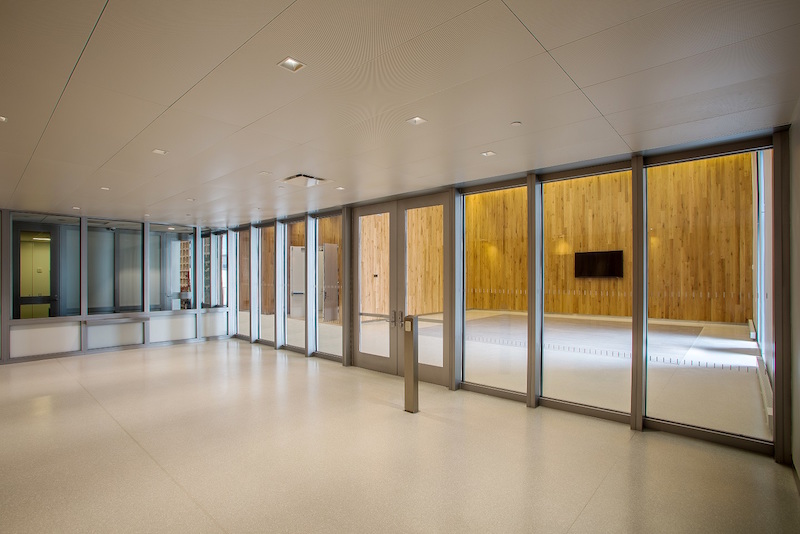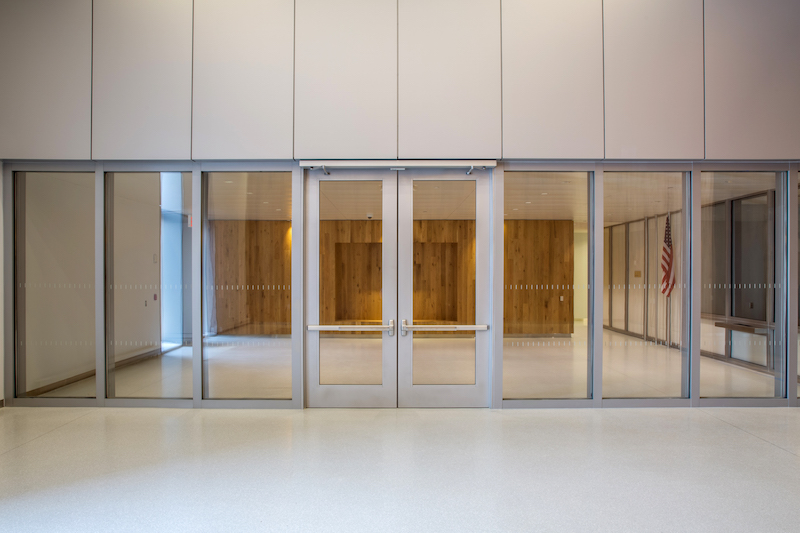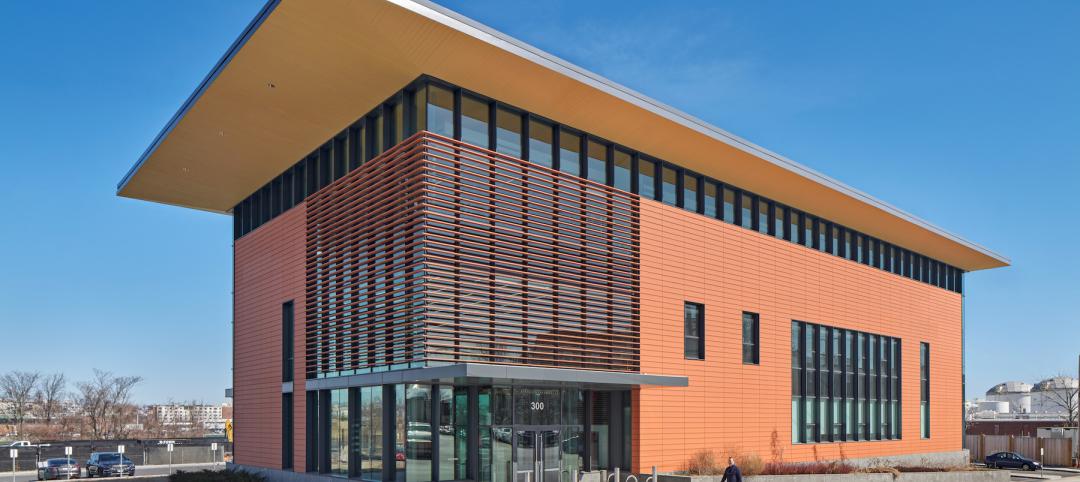Project: Public Safety Facility in the East Coast
Architect: Skidmore Owings & Merrill
Glazing Contractor: W&W, LLC
Blast Consultant: Weidlinger Associates
Products: Fire Resistive/Blast Rated System with SuperLite II-XL 120 in GPX Blast Framing and Fire Resistive/Ballistic Rated System with SuperLite II-XL 120 in GPX Ballistic Framing.
A building’s design is very much influenced by the function it performs and the perceived threats that it may face – whether it’s from natural disasters, accidents or terrorist attacks – with the latter being a foremost concern for federal courthouses, embassies, government facilities and other high profile buildings. For these types of facilities, building materials are chosen based on their ability to mitigate or minimize the injuries and fatalities to occupants during an attack. Because of these security concerns, trade-offs have been made when it comes to daylighting, energy efficiency and aesthetics to name a few. The good news is that today, high-performance security glazing make-ups are available in the market place to meet the level of protection needed while continuing to provide natural light and a feeling of openness. These specialized systems can also blend with the surroundings seamlessly to enhance the building’s overall design.
The 1995 bombing of the A.P. Murrah Federal Building in Oklahoma City revealed the devastating effects of high velocity glass fragments on people in the building or those in the vicinity when a blast occurs. This prompted the General Services Administration (GSA) to establish a blast criteria for all glazing used in federal buildings, which was later on adopted by the Interagency Security Committee (ISC) to broaden its use. Part of its approach is to quantify glass failure not in terms of whether breakage occurs, but rather the hazard it causes to occupants. Today, the ISC Security Design Criteria Blast Protection Levels for Windows is the most widely recognized classification of design levels for glazing hazard protection:
|
Performance Condition |
Protection Level |
Hazard Level |
Description of Window Glazing Response |
|
1 |
Safe |
None |
Glazing does not break. No visible damage to glazing or frame. |
|
2 |
Very High |
None |
Glazing cracks but is retained by the frame. Dusting or very small fragments near the sill or floor acceptable. |
|
3a |
High |
Very Low |
Glazing cracks. Fragments enter space and land on floor no further than 3.3 ft. from the window. |
|
3b |
High |
Low |
Glazing cracks. Fragments enter space and land on floor no further than 10 ft. from the window. |
|
4 |
Medium |
Medium |
Glazing cracks. Fragments enter space and land on floor and impact a vertical witness panel at a distance of no more than 10 ft. from the window at a height no greater than 2 ft. above the floor. |
|
5 |
Low |
High |
Glazing cracks and window system fails catastrophically. Fragments enter space and land on floor and impact a vertical witness panel at a distance of no more than 10 ft. from the window at a height greater than 2 ft. above the floor. |
But what happens when the same blast rated glazing system must also meet 2-hour fire resistive requirements, as well as deliver maximum transparency and seamlessly blend with the existing non-rated systems?
Such was the case with a public safety facility located in the east coast of the United States. The glass wall between the secure entrance and main lobby had to meet both ASTM E-119/NFPA 251 for 2 hours with hose stream as well as Performance Condition 2 of the ISC Security Design Criteria Blast Protection Levels for Windows. Additionally, the assembly had to meet the requirements in UFC 3-340-02, Structures to Resist the Effects of Accidental Explosions, UFC 4-020-01, Department of Defense Security Engineering Facilities Planning Manual and UFC 4-010-01, Department of Defense Minimum Anti-Terrorism Standards for Buildings. There was also an adjacent glass wall by the security officer’s desk that had to meet ASTM E-119/NFPA 251 for 2 hours and UL 752 Level 4 Ballistic.
Given the strict requirements of this project, SAFTI FIRST submitted a certified blast engineering report to the building team for the fire resistive, blast rated system, as well as provide a visual mock-up of the assembly. To achieve the level of fire and blast resistance needed, SAFTI FIRST provided SuperLite II-XL 120 with Heat Strengthened Laminated Glass that met the Performance 2 criteria. It was supplied with the GPX Blast Framing System with a custom designed anchoring system. SAFTI FIRST worked with the design team and blast consultant to ensure that the entire assembly worked with the surrounding structure to meet the required blast performance.
For the fire and ballistic rated system, SAFTI FIRST provided SuperLite II-XL 120 with Level 4 Ballistic Glazing. Some of these panels included an obscure spandrel for areas that needed additional privacy. It was supplied with the GPX Ballistic Framing System to ensure that the entire assembly was compliant.

Since maximum transparency and vision were important design requirements, all the SuperLite II-XL fire resistive blast and fire resistive ballistic glazed assemblies utilized Starphire Low-Iron glass for an ultra-clear appearance despite the robust glass make-up. The GPX Blast and GPX Ballistic Framing systems matched the clean, sharp sightlines and finish of the non-rated systems for a uniform look. Both framing systems were supplied pre-welded and pre-assembled in sections for ease of installation.
The building also benefited from SuperLite II-XL 120’s large clear view areas, with individual panels just under 4,876 sq. inches, which is SuperLite II-XL 120’s maximum clear view area and the largest available at that time (SAFTI FIRST’s SuperLite II-XLB product currently has a largest clear view area at 7,980 square inches).
SAFTI FIRST also provided the large, 10-foot, 90 minute fire resistive pair doors in the glazed assembly. They were supplied with custom hardware that was compatible with the specified card reader to ensure secure access to the building.
The result is a beautiful and elegant glass wall and entrance system that greets building occupants as they enter and leave the facility during work hours, and would protect them from fire, blast or ballistic threats should it occur.
References:
Eve Hinman, P.E. “Blast Safety of the Building Envelope,” Whole Building Design Guide, (October 19, 2011).
Joseph L. Smith, P.S.P. and Nancy A. Renfroe, P.S.P., “Glazing Hazard Mitigation,” Whole Building Design Guide (July 23, 2010).
Related Stories
Government Buildings | Jun 16, 2023
A police station in Boston attempts to bridge the divide separating law enforcement and the public
An investment in workers and residents, the new building is also more efficient and sustainable.
Engineers | Jun 14, 2023
The high cost of low maintenance
Walter P Moore’s Javier Balma, PhD, PE, SE, and Webb Wright, PE, identify the primary causes of engineering failures, define proactive versus reactive maintenance, recognize the reasons for deferred maintenance, and identify the financial and safety risks related to deferred maintenance.
Government Buildings | May 18, 2023
GSA launches first biennial construction award program
Today, the U.S. General Services Administration (GSA) announced the new biennial GSA Construction Award program, which is seeking submissions this summer. The program was created to honor outstanding achievements in construction, with a focus on quality and craftsmanship, collaboration and team dynamics, sustainability, innovation, and technology. The first Construction Awards ceremony will take place in 2024.
Mass Timber | May 1, 2023
SOM designs mass timber climate solutions center on Governors Island, anchored by Stony Brook University
Governors Island in New York Harbor will be home to a new climate-solutions center called The New York Climate Exchange. Designed by Skidmore, Owings & Merrill (SOM), The Exchange will develop and deploy solutions to the global climate crisis while also acting as a regional hub for the green economy. New York’s Stony Brook University will serve as the center’s anchor institution.
Urban Planning | Apr 12, 2023
Watch: Trends in urban design for 2023, with James Corner Field Operations
Isabel Castilla, a Principal Designer with the landscape architecture firm James Corner Field Operations, discusses recent changes in clients' priorities about urban design, with a focus on her firm's recent projects.
Market Data | Apr 11, 2023
Construction crane count reaches all-time high in Q1 2023
Toronto, Seattle, Los Angeles, and Denver top the list of U.S/Canadian cities with the greatest number of fixed cranes on construction sites, according to Rider Levett Bucknall's RLB Crane Index for North America for Q1 2023.
Contractors | Apr 10, 2023
What makes prefabrication work? Factors every construction project should consider
There are many factors requiring careful consideration when determining whether a project is a good fit for prefabrication. JE Dunn’s Brian Burkett breaks down the most important considerations.
Architects | Apr 6, 2023
New tool from Perkins&Will will make public health data more accessible to designers and architects
Called PRECEDE, the dashboard is an open-source tool developed by Perkins&Will that draws on federal data to identify and assess community health priorities within the U.S. by location. The firm was recently awarded a $30,000 ASID Foundation Grant to enhance the tool.
Sustainability | Apr 4, 2023
NIBS report: Decarbonizing the U.S. building sector will require massive, coordinated effort
Decarbonizing the building sector will require a massive, strategic, and coordinated effort by the public and private sectors, according to a report by the National Institute of Building Sciences (NIBS).
Government Buildings | Mar 24, 2023
19 federal buildings named GSA Design Awards winners
After a six-year hiatus, the U.S. General Services Administration late last year resumed its esteemed GSA Design Awards program. In all, 19 federal building projects nationwide were honored with 2022 GSA Design Awards, eight with Honor Awards and 11 with Citations.
















